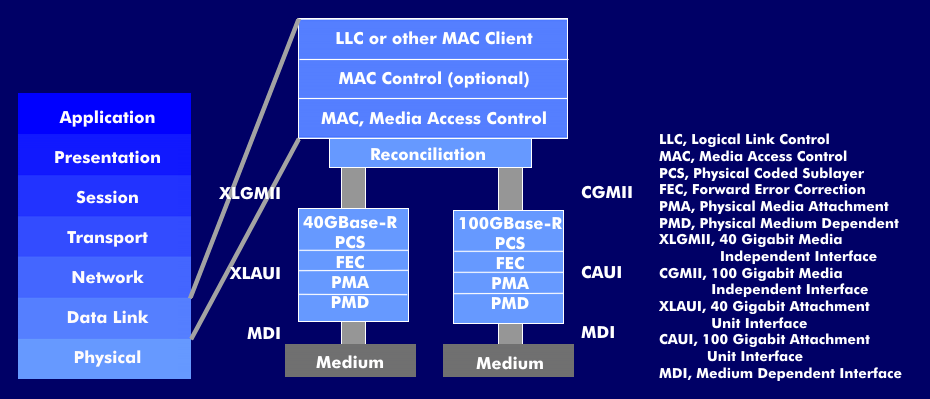IEEE 802.3ba
The Ethernet standards for 40 Gigabit Ethernet and 100 Gigabit Ethernet have been managed by the Higher Speed Study Group( HSSG) since 2008 under the project name IEEE 802.3ba. In contrast to the previous decadal data rates of 10 Mbit/s, 100 Mbit/s, 1 Gbit/s and 10 Gbit/s, the 802.3ba standard is intended to support two different data rates: 40 Gbit/s and 100 Gbit/s. The 40 Gbit/s technology was included to support transmission rates in optical networks.
For the 100 Gigabit technology, there is sufficient demand from network operators and data centers. For example, the high bandwidth could be used for aggregation in the next-generation Internet backbone, as well as in data centers in host buses and storage.
The key points of 40GbE and 100GbE
In defining the standard, cornerstones were established to ensure that 40- and 100- gigabit Ethernet are compatible with existing Ethernet networks. Both technologies support only full duplex, the Ethernet frame format is maintained, as are the minimum and maximum frame lengths, and the bit error rate of maximum `10^-12`. Optical Transport Networks( OTN) are supported by a cooperation with ITU-T, according to which both technologies can transport Optical Transport Units( OTU). 40GbE can transport OTU3 units and 100GbE OTU4 units.
OM class OM4 optical fibers are used as transmission media, with multimode fibers bridging distances of more than 100 m and monomode fibers covering distances between 10 km and 40 km. In terms of interfaces, the 100GBase-ER4 and the 100GBase-LR4 have been specified for four wavelength division multiplexing ( WDM) paths or four monomode fibers and distances of up to 40 km and 10 km, respectively. For multimode fibers, the 100GBase-SR4 is intended for four CWDM paths(Coarse Wavelength Division Multiplexing) over multimode fibers of OM class 3, with which distances of up to 100 m can be bridged. In addition, there is 100GBase-SR10 for ribbon fiber. Transmission is via ten transmit and ten receive fibers.
In addition to fiber optics, the use of copper cables over a distance of 10 m is also to be anchored in the 802.3ba standard. The corresponding interface is the 100GBase-CR10, which works with ten category 7( Cat 7) twinaxial cables connected in parallel.

